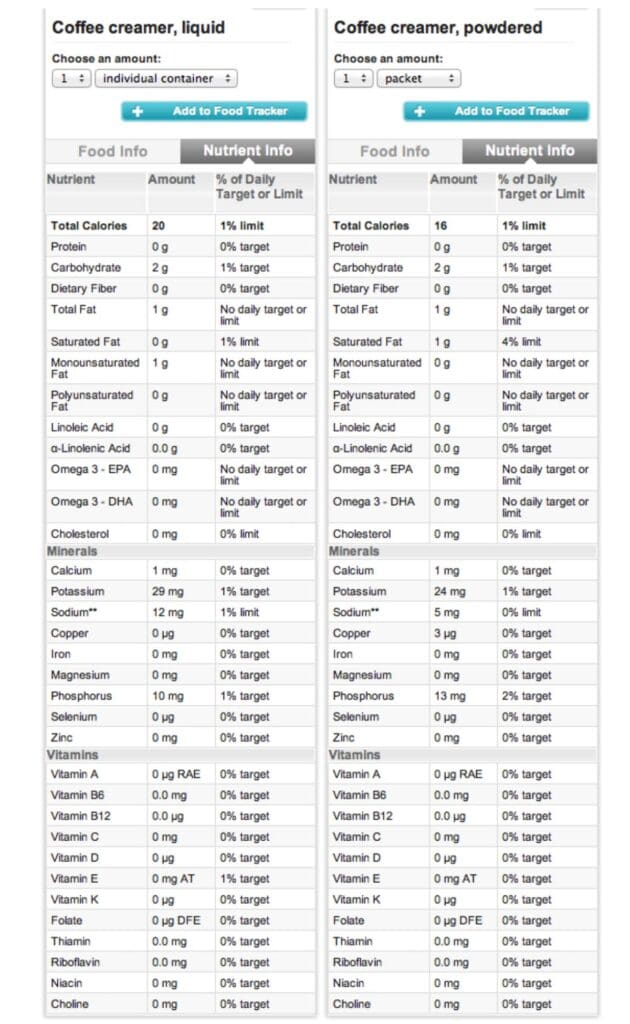You may wonder why your coffee creamer is chunky? Well, there are various possible reasons and answers. The simple answer is that you may have used an expired product. Or it may be something complicated, like the adverse reaction of acidic coffee beans with the creamer's acidity or base ingredients.
How many times have you looked forward to drinking a hot cup of steaming coffee, only to have it ruined upon adding your creamer?
And while you may be used to seeing white chunks and oily, floating globules on your coffee, it can get frustrating and irritating.
It's even more frustrating when the creamer seemed and looked to be okay. You definitely wonder why this happens and has questions.
So you need to be more specific to get a proper answer to your question. And all you have to do is keep reading to find out how to ensure your creamer remains smooth through the brewing process.

What is coffee creamer?
It is a powder or refrigerated liquid available at stores, which you can add to coffee or black tea instead of milk products like cream or half-and-half. However, the difference is that coffee creamer is dairy-free, unlike heavy cream and half-and-half.
Coffee creamers are not really cream per se. That's why they are called "white whiteners" most of the time
In that case, what's in the name that's not literally "cream"? It all comes down to three primary ingredients: sugar or artificial sweetener, hydrogenated oil, and thickener.
Many people add them to hot beverages to improve their taste and sweetness. While they are usually non-dairy and lactose-free, some coffee creamer brands may contain milk derivatives like casein.
Besides, coffee creamers last longer than milk products, especially powder variants. They are widespread in the US and available in multiple flavors, including seasonal options.
Depending on where you live, you may get different coffee creamer types and flavors.
While the different brands may have various ingredient compositions, the base ingredients for most brands are water, vegetable oil, and sugar.
Liquid vs powdered coffee creamers
There are a few shelf-stable creamers available in the market, but the main difference between these two varieties is how you store them. You can store powdered creamers in the pantry or cupboard and don't require refrigeration. Quite the reverse for the liquid creamers as most of them need to be refrigerated after opening.

Coffee creamers are available in two primary forms - powdered or liquid.
1 Liquid creamers
You usually find them in the dairy section, available in multiple flavors ranging from hazelnut to vanilla to cookie flavor. There are also low-fat and sugar-free liquid creamers, and it's common to see small, single-serve creamer cups at diners.
Liquid creamers are different from half-and-half. They are primarily made of sugar, vegetable oil, thickeners, and flavoring agents. You can find them as single-serving cups, bottles, or tetra-pack boxes.
2 Powdered creamers
While there are different-flavored powdered creamers, plain sweetened milk flavor is most common. They are available as scoopable containers and individual packets, predominantly found at coffee stations.
Why is my coffee creamer chunky?
Coffee is my favorite drink, but with a shade of mystery. I'm sure, like myself, you may have many a time noticed the cream instantly curdling while pouring yourself a cup of coffee. And at times, the cream mixes as smooth as silk, without any curdling.
This makes you wonder, what makes a creamer curdle?
It's because of two main reasons:
1 Date of expiry
If your carton of milk is past its expiry date, it will most likely turn into a lumpy mush with time. It's because the lactic acids in cream build up with time to curdle on their own eventually.
While this is one way to curdle dairy, adding some acidic liquid like lemon juice or coffee is another way.
2 Acidity
The pH scale determines the acidity, or how basic or acidic a water-based solution is on a scale of 0 to 14. Solutions registering 0 to 7 on the scale are acidic, and solutions reporting 7 to 14 are considered basic.
Coffee varieties are generally acidic, registering an acidic pH value of 4.85 to 5.10. (source)
During the coffee brewing process, coffee beans release nine main acids. And it's these acids that give the coffee its unique flavor. Coffee contains nine primary acids which from highest to lowest concentration are:
- Chlorogenic
- Quinic
- Citric
- Acetic
- Lactic
- Malic
- Phosphoric
- Linoleic
- Palmitic
Fives ways to reduce acidity levels
As some people are intimidated by the acidity of coffee, these measures help reduce it:
- Start using dark roast grounds instead of light roasts
- Start using coarser grinds
- Try increasing brewing time by perhaps using a French press
- Try brewing coffee at low temperatures
- Start drinking cold coffee, and not hot coffee
According to The Eagle, overly acidic coffee only quickens the curdling process when mixed with older cream, and its acid increases the cream's pH balance, triggering instant curdling.
Dairy products contain proteins like casein which remain stable without clumping in liquid milk. The proteins break down, attach, and start curdling when you add acid to them. While this is a necessary process in some dairy products like yogurt and cheese, it isn't very pleasant in your cup of coffee!
Coffee acidity variations
Coffee acidity levels depend on various factors like:
1 Roasting
The coffee roasting duration and temperature determine coffee acidity. According to a study, coffee's chlorogenic acid levels reduce the longer and hotter you roast coffee beans. It thus indicates that darker coffee roasts are less acidic than lighter coffee roasts.
2 Brewing time and method
The brewing method also affects coffee acidity levels. According to another study, hot coffee is significantly more acidic than cold-brewed coffee.
The brewing method also affects coffee acidity levels. According to another study, hot coffee is significantly more acidic than cold-brewed coffee.(source)
The brewing method also affects coffee acidity levels. According to another study, hot coffee is significantly more acidic than cold-brewed coffee.(source)
Even the brewing time affects coffee's overall acidity levels. A shorter brewing time gives a more acidic cup of coffee, while longer brewed coffee is less acidic. (source)
3 Size of coffee grounds
Not many know that the coffee ground size also affects coffee acidity levels. Smaller grounds are exposed to more significant volume areas, thus increasing acid extraction during the brewing process. So don't be surprised if you end up with a more acidic cup of coffee if you use finer coffee grounds!
4 The coffee creamer
Yes, your coffee creamer indeed is one of the most likely triggers for chunky creamer. And the best way to eliminate this trigger is by knowing and using the suitable creamer.
For example, there's a higher chance of poorly processed non-dairy creamers with nut milk as the base ingredient curdling.
While coffee acidity is usually enough to cause curdling, even high temperatures can separate or curdle your cup of coffee.
You may also face problems if you store your powdered creamer in the fridge. It's because powered creamers don't require refrigeration. And if you do keep it somewhere cold, the added moisture leads to clumping, thus hindering the creamer's ability to dissolve when mixed with your coffee.
Read: Can you Freeze Liquid Coffee Creamer?
How coffee affects curdling
Coffee has an average pH balance of 4.85 to 5.10, where the lower numbers indicate higher acidity. As coffee is usually acidic, adding creamer to a hot cup increases its curdling risks. The chances of the creamer curdling are also higher if you use lighter roasts, as they are more acidic than darker roasts.
Besides, the chances of creamer in the fridge for some time curdling are higher when mixed with acidic, super-hot coffee. It's because coffee heat increases the chances of old creamers curdling.
The news is that it's safe to drink your coffee or tea if this coffee side effect- beverage feathering, happens (according to Nestle). Adding acid or heat to milk is called 'intentional curdling,' which is how they make the cheese.
However, you can get sick by any unintentional curdling of milk caused by milk past its expiry date or left out all day.
Even soy milk may curdle in hot and acidic coffee. It is, however, possible to prevent this unsightly occurrence.
Tips to prevent coffee creamer from curdling
Most coffee creamers, including soy and almond milk, tend to curdle or coagulate with sudden temperature changes. It's due to the creamer proteins reacting to temperature changes induced by coagulating or clumping.
These six tips ensure your coffee creamer remains smooth and silky:
1 Consume less acidic coffee
Less acidic coffee helps prevent the curdling of creamers. It's because high acidity coffee grounds disturb a cup of hot coffee's pH balance when mixed with coffee creamers.
2 Get rid of old creamers.
Always smell your creamer before pouring it into your coffee. Discard anything that smells like it's on the edge of heading south. It's because lactic acid accumulates in old creamers, which tends to curdle quicker than before.
While creamers a few days past the expiry date should be safe, it's better to use fresh cream where possible.
3 Use darker roasts
I use lighter roasts as I'm not too fond of acidic coffee. So if you have always used lighter roasts, it's time to switch to darker coffee grounds to see the difference.
4 Cold coffee
As hot coffee easily breaks down the creamer casein, it's always better to add creamer to coffee when it's at or below a temperature of 180 to 190°F.
This is the acceptable temperature range for brewing coffee, and it's the temperature you get when you let your coffee cool for about 60-90 seconds before adding creamer.
Read: Ca Phe Sua Da | Vietnamese Coffee
5 Add creamer first
You can also avoid overheating your creamer by first pouring it into your cup and then gently adding coffee. This method also proves helpful as it counterbalances the milk with the coffee's temperature.
Restaurants usually adopt this method, letting the coffee do most of the work without spoons or kitchen tools.
6 Try using heavy cream or whole milk.
The fat cells surrounding the proteins ensure half-and-half or heavy cream doesn't quickly curdle. The only things you need to look out for are the calories!
Should I use coffee creamer or half-and-half?
Both creamer and half-and-half are common coffee additions that blend well with bitter black coffee or black tea.
Half-and-half constitutes equal portions of whole milk and cream, giving it the perfect thickness and richness. It's also a common addition to desserts and creamy, savory dishes.
Coffee creamer is usually dairy-free, without any milk products. While it's as thick as half-and-half, it contains a significant amount of sugar. While there are also sugar-free options, coffee creamers are used only to add to drinks.
Tips for using creamer
Coffee creamers are available ready to use, in powder or liquid form, and you just have to add to your coffee, stir and drink. As some creamers are sweeter than others, it's better to start by adding a little and adding more as per taste.
You will have to stir more for powdered creamers to dissolve and preferably use liquid creamers with iced coffee.
How does it taste?
Creamer is usually sweetened and flavored, with a texture and flavor similar to whole milk or half-and-half. Caramel, hazelnut, pumpkin spice, almond, vanilla, and chocolate are popular flavors.
You can better enjoy them after adding to coffee and tea and not on their own. This especially applies to powdered creamers, which you must mix in liquid like coffee or tea before consuming.
Creamer substitutes
There are various coffee creamer substitutions you can use like:
- Half-and-half
- Whole milk
- Heavy cream
- Non-dairy milk
- Evaporated milk, which has a good shelf life
You can add sugar if you need a sweetened creamer. If you prefer something pre-sweetened, you can try sweetened condensed milk. While you can always use milk powder in powdered creamer, it won't be as creamy and sweet as powder creamers.
Coffee creamer recipes
Creamer lightens and sweetens hot or cold black coffee, tea, or espresso. While you can make your dairy-based version, as most creamers are non-dairy, use it as a vegan alternative for your coffee drinks. Here are some recipes you can try:
Where to buy creamer
Coffee creamer is available in:
- American grocery stores
- Supermarkets
- Convenient stores
- As part of coffee service in casual restaurants
You can usually find eight, 16, or 32-ounce glass or plastic bottles of liquid coffee creamer in the refrigerated dairy section. Powdered creamer is generally found in various sized plastic bins or paper boxes next to coffee beans.
Both creamer options are also available as bulk packages in big box stores.
It would be best to consider a few things while buying a suitable creamer. You need to find a creamer that suits your tastes and dietary requirements based on its flavor, fat content, sugar content, and ingredients.
Storing coffee creamers
There are three main coffee creamer options available:
- Liquid creamers sold in large tetra packs and plastic bottles
- Mini version liquid creamers sold in little sealed cups
- Powdered whiteners
Now here's how you can store each variety.
Just like you store your half-and-half, you have to store it in the fridge once you buy a creamer. Don't forget to keep the container sealed when not in use.
1 Storing tetra packs
Except for canned evaporated milk, most creamers available in tetra packs and plastic bottles are non-dairy products. That is why you find them sitting on supermarket shelves.
And it's perfectly safe and okay to keep unopened containers at room temperature. You can store them in the pantry or kitchen, as long as you keep them away from any heat source like the stove.
However, you need to refrigerate the pack or bottle once you open it. And don't forget to keep it tightly sealed when not in use. That's why these products come with the label 'refrigerate after opening.'
However, the coffee creamers you find in the refrigerated section are usually dairy creamers, and they have to be refrigerated all the time.
2 Storing mini sealed cups
You can keep the single-cup at room temperature from the moment you buy it till you open it. And there is nothing more to remember about It. just that you have to ensure you keep the package away from heat.
Storing powdered coffee whiteners
They require just as much care and storage needs as any other powdered Item like powdered milk. So all it requires is ensuring you seal the container tightly and keep it away from moisture.
Bottomline:
In short, you need to remember that: It is better to store liquid creamers in the fridge in their original packaging.
Liquid creamers remain suitable for consumption for a month or longer if unopened and up to two weeks once you open them.
Store your powdered creamer in an airtight container, and keep it in a cool and dry place. Unopened powdered cream stored this way will last for up to two years. However, an opened pack of powdered creamer will last for only six months.
How long will coffee creamer last?
Any coffee creamer product, be it powder, refrigerated, liquid, or shelf-stable variant. They will eventually go bad. That is why producers provide a 'best before date' or a 'use by date' for all their products. This is to let you know how long you can safely consume it.
The date mentioned on the product is an estimated date the producer provides, ensuring the product remains in its best quality if stored under proper storage conditions.
However, consuming any product before the date is always better to enjoy the best quality product.
There always is the possibility of the coffee creamer going bad before the date. However, it usually happens if the container is damaged or if you didn't store it properly.
As powdered coffee creamers last longer than other types, it is your preferred choice if you will occasionally be using creamers. While there is no need to refrigerate this product, finish it within 2-3 months to enjoy its peak quality. It may last for 3-6 months after the date too.
Mini cup liquid creamer may be shelf-stable but not as long-lasting as powdered creamer. While it varies between producers, most brands last for 6-9 months after the production date, which you can find on its label.
As dairy and non-dairy liquid coffee creamer are not so durable, it is better to stick to the date on its label. This may differ depending on the brand, so it's better to check the label. And make sure to consume it within one or two weeks after opening.
While the product may still be good even after passing the date, there is the risk of it spoiling faster. So check for signs of possible spoilage before adding to your coffee.
Signs of coffee creamer gone bad
In the case of liquid creamers, look for any change in its taste, smell like something sour or off-odor, and texture like clumps and liquid becoming clumpy.
Test the taste by first drinking a teaspoon if you think your creamer may have gone bad. You can continue using it and adding it to your drink if it's good enough, and if not, throw it away.
In addition to these factors, you mainly have to check the dates of opened containers. Unless the producer specifies that the creamer stays okay for a long time, throw away bottles or packs you have kept stored for more than three weeks.
In the case of powdered creamers, look for signs of mold and any changes in texture. As long as no moisture enters the package, most powders usually stay fine for years.
The best check for a powdered creamer quality lies in brewing a cup of coffee. You know the powder is fine if everything tastes okay. However, if you notice that the flavor seems not to the standards or even slightly off, it's better to throw away the package.
Final thoughts
If you wonder why is my coffee creamer chunky, it is because of two main reasons—the high acidity of the coffee beans and the coffee creamer's increased lactic acid content.
As long as you can control these factors, you will be able to prevent the cream from curdling in your coffee. However, if you use a healthy coffee creamer option, any unintentional curdling is safe for your health.
I recommend following the methods mentioned above to prevent the intentional curdling of your coffee.




